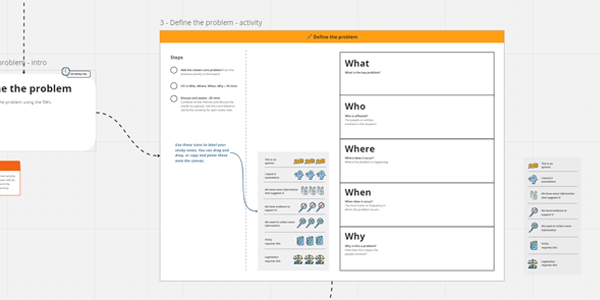Gather background information
Collect any relevant data or information related to the area you want to explore. This could include user feedback, market research, industry reports, or internal data. Reviewing this information can help participants understand and define the problem better and generate more informed ideas during the workshop.
Invite your participants
Participants in this session should be made up of the project team and any subject matter experts relevant to the project. This might include a Project Manager (PM), Project Officer, Designer, Business Analyst, Communications Officer, Solution Architect, or Developer. Aim for including a range of people to form a multi-disciplinary team.
If key team members are missing from the discussion, there is a high risk of starting out with unrealistic goals and incomplete information.
Communicate the purpose and goals of the workshop to all participants beforehand. Make sure everyone understands what is expected of them. You’ll want to make sure when you send an invite for the session, that you clearly explain the goal, how long it’ll take, and why people’s participation will be beneficial. You can use the provided template to make it easy.
It’s important to give enough notice to ensure participants have free time to come along to the session. Aim to send invitations about 2 weeks in advance.
You can also include the play for people to look at ahead of time.
Calendar meeting request for problem definition
Subject:Writing a problem statement for [your project]
Meeting description:Hi [team name if sending a group invitation, or participant name if sending individual invitations]
To kick off [project name], I want to start by defining the problem as a team to ensure we solve the right problem.We will be using Miro for this workshop and you can view the template [insert miro template link here] we will be using in advance of the session.
Agenda:
Goal of the session
Overview of problem space
Problem definition activity
Problem brainstorm
Synthesise and discussion
State the problem
Wrap up
[If you have pre-work/documents attached please review the documents attached prior to the session as they will help you to brainstorm the problem]
I look forward to your contribution to the session.
Kind Regards,
[Facilitator name]
Setting up the tools
For remote teams, use the Miro template provided. Share the Miro template in advance with your team so they know what to expect in the session.
For in-person teams book a room and prepare sticky notes and markers. A whiteboard or butcher’s paper is needed for the main activities. If you are running an in-person workshop, you can draw sections that are similar to the Miro board template, where people can add their physical sticky notes. Don’t worry about how it looks or matching the Miro template, just make sure there is an area designated for each activity.
Send any relevant supporting data you have in advance to the team. This might be existing data sets, previous project reports or the project plan.
Tip
If the problem might be around your users, prepare the team by gathering and sending them as much relevant user information as possible.




